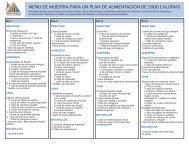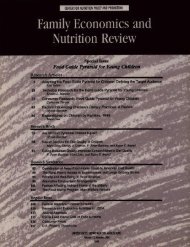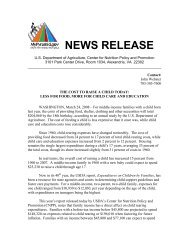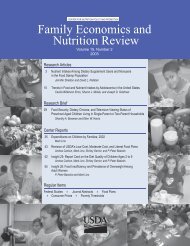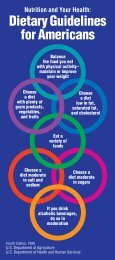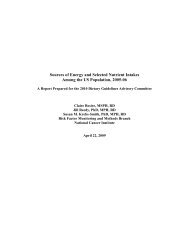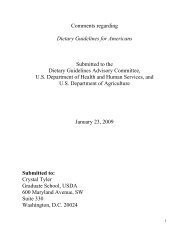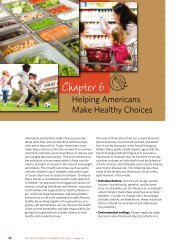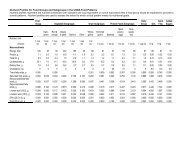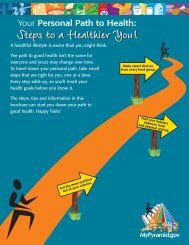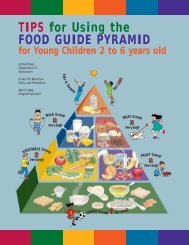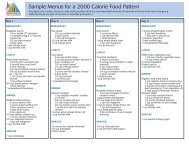Elderly Nutrition - Center for Nutrition Policy and Promotion - US ...
Elderly Nutrition - Center for Nutrition Policy and Promotion - US ...
Elderly Nutrition - Center for Nutrition Policy and Promotion - US ...
Create successful ePaper yourself
Turn your PDF publications into a flip-book with our unique Google optimized e-Paper software.
increasing portion of the budget<br />
must be devoted to health care <strong>and</strong><br />
prescription medications (Quinn,<br />
Johnson, Poon, Martin, & Nickols-<br />
Richardson, 1997).<br />
While assistance is available through<br />
the U.S. Department of Agriculture’s<br />
(<strong>US</strong>DA) Food Stamp Program to help<br />
the economically disadvantaged,<br />
concern exists that all those who are<br />
eligible do not participate <strong>and</strong> that<br />
benefit levels are low, compared with<br />
need (Shotl<strong>and</strong> & Loonin, 1988).<br />
Some research has suggested that it<br />
costs more to eat a more healthful<br />
diet (Blaylock, Smallwood, Kassel,<br />
Variyam, & Aldrich, 1999); thus,<br />
low income can restrict not just the<br />
quantity but the nutritional quality of<br />
food purchased as well. Low income<br />
can also reduce consumers’ ability to<br />
substitute market-produced meals <strong>for</strong><br />
home-cooked versions as their desire<br />
<strong>and</strong> ability to shop <strong>and</strong> prepare meals<br />
decline.<br />
Lower levels of education have been<br />
associated with inadequate nutritional<br />
intake in the elderly (Bianchetti,<br />
Rozzini, Carabellese, Zanetti, &<br />
Trabucchi, 1990; Dewitt, Douglas,<br />
& Matre, 1989). <strong>Nutrition</strong> knowledge<br />
has been found to have a weak, but<br />
positive, association with diet adequacy<br />
(Howard, Gates, Ellersieck, &<br />
Dowdy, 1998).<br />
Schoenberg (2000) identified four<br />
“pathways” of nutritional risk <strong>for</strong><br />
rural Black elderly: (1) changes in the<br />
physical <strong>and</strong> social importance of<br />
food, (2) lack of access to necessary<br />
resources, (3) increased physical<br />
limitations, <strong>and</strong> (4) misin<strong>for</strong>mation<br />
about diet <strong>and</strong> nutrition. Lee,<br />
Templeton, Marlette, Walker, <strong>and</strong><br />
Fahm (1998) discovered nutritional<br />
deficiencies in food energy, dietary<br />
fiber, <strong>and</strong> calcium among southern<br />
Black rural elderly. Diet variety appears<br />
to be lower <strong>for</strong> Blacks, compared with<br />
other racial groups (Dewitt et al., 1989).<br />
In addition, Blacks are also more likely<br />
than Whites to have inadequate<br />
nutritional intake because of weight<br />
changes, illnesses, <strong>and</strong> oral problems<br />
that interfere with appetite <strong>and</strong> eating<br />
(Nickols-Richardson, Johnson, Poon,<br />
& Martin, 1996).<br />
Loneliness due to death of spouse or<br />
friends can diminish the social reasons<br />
<strong>for</strong>, <strong>and</strong> pleasures associated with,<br />
eating (Shifflett & McIntosh, 1983;<br />
Walker & Beauchene, 1991). Eating<br />
regular meals <strong>and</strong> having an adequate<br />
diet have been found to depend, at least<br />
in part, on eating with others (Doan,<br />
1990; Shifflett & McIntosh, 1983;<br />
Walker & Beauchene, 1991). Having<br />
few shared meals has been associated<br />
with higher levels of nutritional<br />
risk among rural elders in eastern<br />
Pennsylvania (Hendy et al., 1998)<br />
<strong>and</strong> with higher risk of food insecurity<br />
in rural Appalachia (Qu<strong>and</strong>t & Rao,<br />
1999). Fewer than a third of a<br />
nationally representative sample of<br />
elders experiencing food insufficiency<br />
were married, compared with more<br />
than half of those consuming a<br />
sufficient diet (Sahyoun & Basiotis,<br />
2001).<br />
Vitamin <strong>and</strong> mineral supplementation<br />
can offset some of the nutritional<br />
deficiencies in the elderly. A study of<br />
healthy, independent-living Canadians<br />
age 65 to 74 revealed that vitamin C<br />
supplements were used most often by<br />
both genders, but about three times as<br />
many women, compared with men, took<br />
a calcium supplement. In general, use<br />
of supplements significantly increased<br />
nutrient intake; <strong>and</strong> the risks <strong>for</strong><br />
deficiency were eliminated <strong>for</strong> vitamin<br />
A, vitamin B 12 , folacin, <strong>and</strong> zinc<br />
(Donald et al., 1992).<br />
This current study uses nationally<br />
representative data on single women<br />
age 65 <strong>and</strong> older from the 1994-96<br />
Continuing Survey of Food Intakes by<br />
Individuals (CSFII) <strong>and</strong> the Diet <strong>and</strong><br />
Health Knowledge Survey (DHKS)<br />
conducted by <strong>US</strong>DA. Single women<br />
are of interest because the incidence<br />
of food insufficiency is relatively<br />
greater <strong>for</strong> the single elderly population<br />
(Sahyoun & Basiotis, 2001). They are<br />
also of interest because of their<br />
generally longer lifespans <strong>and</strong><br />
consequently their prolonged risk<br />
of experiencing the pathological,<br />
physiological, economical, <strong>and</strong> social<br />
losses associated with poorer diet<br />
quality. In addition, women’s longer<br />
average lifespan means that they<br />
are more likely to experience the life<br />
changes associated with a decrease in<br />
the quantity <strong>and</strong> quality of food intake<br />
(Nickols-Richardson et al., 1996;<br />
Qu<strong>and</strong>t & Chao, 2000).<br />
Research indicates that health problems<br />
related to inadequate nutrition<br />
are more prevalent in rural areas<br />
(Qu<strong>and</strong>t & Chao, 2000; Schoenberg,<br />
2000; Shotl<strong>and</strong> & Loonin, 1988). Rural<br />
residents also mention transportation<br />
to <strong>and</strong> from food markets as a structural<br />
barrier to obtaining adequate food<br />
(Hendy et al., 1998; Lee et al., 1998;<br />
Wallace, Pascarella, & Campanella-<br />
Voica, 1997). Consequently, the effect<br />
of rural residence on single elderly<br />
women achieving adequate nutrition<br />
is considered in this research.<br />
This study evaluates nutrient intake<br />
among single elderly women residing in<br />
rural <strong>and</strong> nonrural areas <strong>and</strong> examines<br />
the relative importance of single elderly<br />
women’s resources, health status,<br />
attitudes, <strong>and</strong> practices related to food<br />
procurement <strong>and</strong> processing, as well<br />
as demographic characteristics in<br />
achieving adequate nutrition.<br />
2003 Vol. 15 No. 1 75



